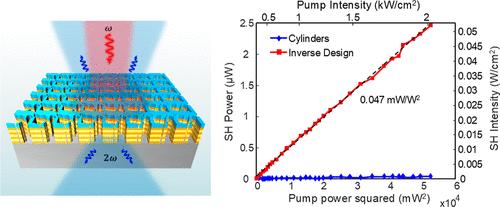全介质非线性极性元表面的逆设计
IF 16
1区 材料科学
Q1 CHEMISTRY, MULTIDISCIPLINARY
引用次数: 0
摘要
由于光子共振和材料特性之间的相互作用,非线性超表面提供了实现光学非线性器件的能力,与非线性晶体相比,非线性器件具有无与伦比的性能。非线性光信号的效率和发射方向与光子共振的存在、定位和寿命以及非线性磁化率之间复杂的相互依赖关系,使得使用传统材料和几何结构设计最佳超表面变得极其困难。基于拓扑优化的逆设计是光子结构设计的有力工具,但传统的线性光子设计方法不适用于此类高维非线性问题。在这里,我们使用拓扑优化方法来反设计一个制造鲁棒的非线性超表面,其中包括半导体异质结构中的量子工程谐振非线性,以实现高效和定向的二次谐波产生。此外,我们还证明,在实际约束下,在所有参数中,非线性模态重叠成为提高转换效率的主要参数,这一发现与经常强调Purcell增强的直觉驱动研究形成对比。我们的研究结果展示了一种有效的方法来优化纳米光子结构中的非线性过程,用于经典和量子光源,量子信息应用和通信。本文章由计算机程序翻译,如有差异,请以英文原文为准。

Inverse Design of an All-Dielectric Nonlinear Polaritonic Metasurface
Nonlinear metasurfaces offer the ability to realize optical nonlinear devices with unparalleled properties compared to nonlinear crystals, due to the interplay between photonic resonances and materials properties. The complicated interdependency between efficiency and emission directionality of the nonlinear optical signal on the existence, localization, and lifetimes of photonic resonances, as well as on the nonlinear susceptibility, makes it extremely difficult to design optimal metasurfaces using conventional materials and geometries. Inverse design using topology optimization is a powerful design tool for photonic structures, but traditional approaches developed for linear photonics are not suitable for such high dimensional nonlinear problems. Here, we use a topology optimization approach to inverse-design a fabrication-robust nonlinear metasurface that includes quantum-engineered resonant nonlinearities in semiconductor heterostructures for efficient and directional second harmonic generation. Furthermore, we also demonstrate that under practical constraints, among all the parameters, the nonlinear modal overlap emerges as the dominant parameter that enhances conversion efficiency, a finding that contrasts with intuition-driven studies that often emphasize Purcell enhancement. Our results demonstrate an efficient approach for optimizing nonlinear processes in nanophotonic structures for classical and quantum light sources, quantum information applications, and communication.
求助全文
通过发布文献求助,成功后即可免费获取论文全文。
去求助
来源期刊

ACS Nano
工程技术-材料科学:综合
CiteScore
26.00
自引率
4.10%
发文量
1627
审稿时长
1.7 months
期刊介绍:
ACS Nano, published monthly, serves as an international forum for comprehensive articles on nanoscience and nanotechnology research at the intersections of chemistry, biology, materials science, physics, and engineering. The journal fosters communication among scientists in these communities, facilitating collaboration, new research opportunities, and advancements through discoveries. ACS Nano covers synthesis, assembly, characterization, theory, and simulation of nanostructures, nanobiotechnology, nanofabrication, methods and tools for nanoscience and nanotechnology, and self- and directed-assembly. Alongside original research articles, it offers thorough reviews, perspectives on cutting-edge research, and discussions envisioning the future of nanoscience and nanotechnology.
 求助内容:
求助内容: 应助结果提醒方式:
应助结果提醒方式:


